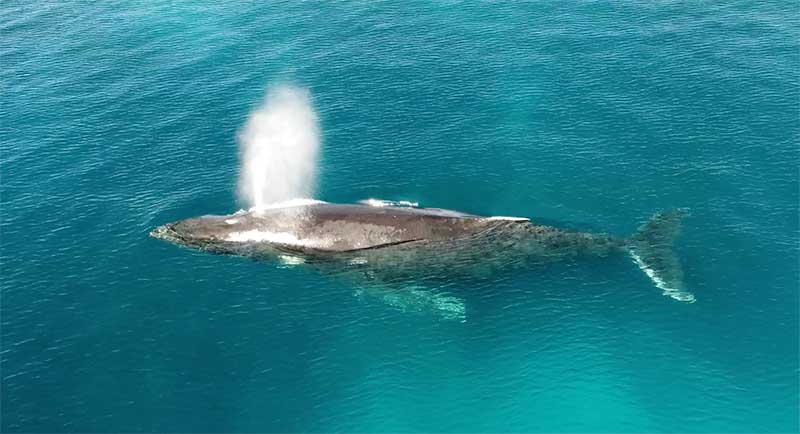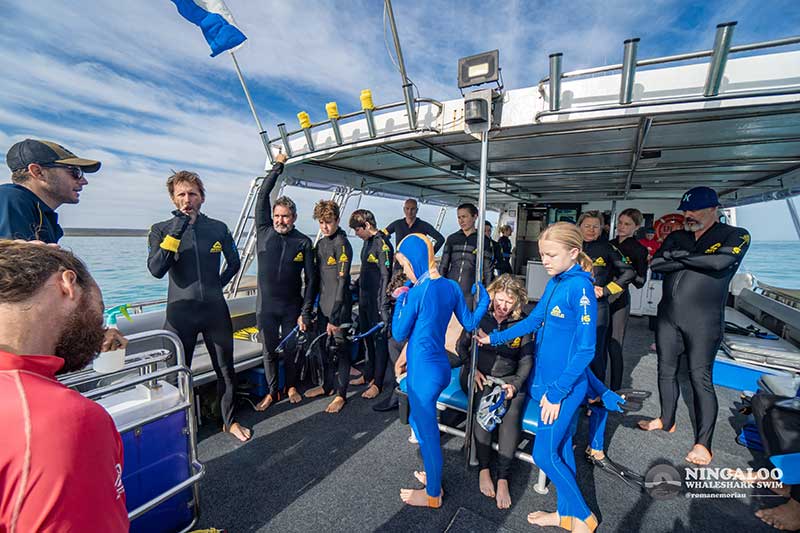Safety during Humpback Whale Interactions
Our commitment is to minimise the impact of in-water interactions on the humpback whales, whilst simultaneously prioritising the safety of our guests. Adventure tourism will always involve a degree of risk – our job is to minimise this as much as practical.
Our experienced pilot is consistently on the lookout for a suitable pod of whales to interact with. Not only does an interaction with a suitable pod increase our chances of success, but it also ensures the safety of all involved. The determination of a suitable pod is based on its:
- Speed – Slower whales are favoured as whales travelling at speed are much harder to successfully interact with as the time to line-up a group is reduced.
- Behaviour – Any wild behaviours or surface-active whales (breaching or slapping whales) are avoided for in-water interactions.
- Location – Whales in shallower water are much easier for our spotter pilot to track, which allows them to monitor their behaviour for longer.
- Pod members – Small calves can often be obscured by their mother at sea level. The spotter plane provides a vantage point to see calves where the vessel may not, which allows us to steer clear and minimise our disturbance of mothers and calves.

Our thorough briefings are designed to ensure you comprehend the necessary steps to maximise your chances of interacting with a humpback whale while prioritising your safety. Every member of our crew not only meets, but exceeds the minimum training guidelines for working with guests in a marine environment. The majority are dive professionals and accredited snorkel guides, each equipped with Advanced First Aid, CPR, and Oxygen training.
We have an extensive first aid kit, and oxygen and defibrillator are always available onboard.
To ensure a safe and personalised experience, each group entering the water is accompanied by at least two dedicated crew members – our knowledgeable guide and skilled photographer. We cap the size of our in-water groups to ensure your interaction experience is optimised. Your safety is paramount, and it’s crucial to heed your guides’ instructions in the water – ours are chosen because they are inherently friendly, helpful and they care. (Most have years and years of experience working in the ocean with guests of all shapes, sizes and ages too.)
For in-water interactions, the use of flotation devices such as pool noodles or life jackets is not permitted. This advanced snorkelling tour requires participants to swim unassisted for at least 200m in the open ocean. If, for any reason, you feel unable to do so on the day or become uncomfortable, please promptly inform one of our attentive crew members.
As with any wild animal encounter, there is a risk of physical injury during an in-water interaction, particularly if someone is struck by the whale’s tail, fins or body or does not approach the boat to exit the water with caution. To minimise this possibility, please ensure you:
- Closely follow the world’s best practice in-water interaction protocols developed by the Department of Biodiversity, Conservation and Attractions in Western Australia that you will be briefed on before entering the water.
- While in the water listen to and immediately follow all instructions from your guides from start to finish of your in-water interaction.
Safety during snorkels
Entering into the waters of Ningaloo, you might encounter a mix of jellyfish species, thanks to the ever-changing currents and winds. Don’t worry, though—serious jellyfish stings are pretty rare in these parts, but we keep an eye out from start to finish of our guests being in the water.
We prioritise your safety by taking every possible measure to manage and minimise the risk of jellyfish stings. Onboard, you’ll find full-coverage stinger suits, and we’ve made them a must if there have been recent jellyfish sightings or stings. Our skilled crew knows the drill, from spotting symptoms to delivering the right treatment, and we’ve got all the gear onboard. We follow well-established procedures for handling stings of all levels, ensuring your safety is our top priority.

In collaboration with the Department of Biodiversity, Conservation, and Attractions, local emergency response services, and fellow tourism operators, we ensure a coordinated and rapid response to any potential emergencies. Your safety is our top priority, and we are dedicated to handling any situation with speed, efficiency, and professionalism.
Shark encounters are very common on the Ningaloo Reef. It is often you will see a reef shark on your snorkel, even a whaler shark or tiger shark while you are waiting for your interaction. It’s important to note that there has never been an incident with a shark on a tour in the history of all tours in Exmouth since the 1980’s. All reported shark bites in the Ningaloo area are from people fishing or spear-fishing or feeding fish. Our crew are shark lovers and will be happy to ease your worries and educate you more about how amazing and worthy of our protection these amazing creatures are.
Seasickness
Seasickness can be a concern for our guests during the tour, whether due to a predisposition to motion sickness or fluctuating weather conditions. We prioritise safety, and if weather conditions are deemed unsafe, the tour won’t proceed. However, in some instances, our tours may proceed in safe yet less-than-ideal weather conditions.
Rest assured, our vessel, Seazone, is purpose built for stability in the dynamic conditions off the West Coast of Australia. Beyond stability, Seazone offers a comfortable and spacious environment, providing you ample room to relax and enjoy your experience throughout the day.
Some things you can do to avoid seasickness:
- Medicate – Before leaving home, ask your doctor for the best seasickness medication available. Not all seasickness medication works for everyone. Most importantly, ensure you take this medication well beforehand to achieve effective blood levels, as motion sickness prevents effective drug absorption.
- Alternative methods – sea sickness bands, seasickness glasses and the use of ginger may all be effective for some individuals in decreasing the likelihood of seasickness or decreasing the discomfort level.
It’s important if you do become seasick on a tour to inform a crew member so we can assist you. It’s best to find a quiet well-ventilated area and remain as still as possible whilst breathing slowly and deeply. For best results, you should focus on the horizon to create stability. Our crew can offer ginger chunks and ginger tea to reduce any symptoms as ginger soothes the stomach. Regardless of what eventuates, the most important thing is to ensure you keep drinking as much water as you can during your tour.
Although there is no one cure for all seasickness cases, please know that the crew will be there to assist to the best of our abilities.
If you have any other questions or concerns. Please reach out to our team for further assistance.





